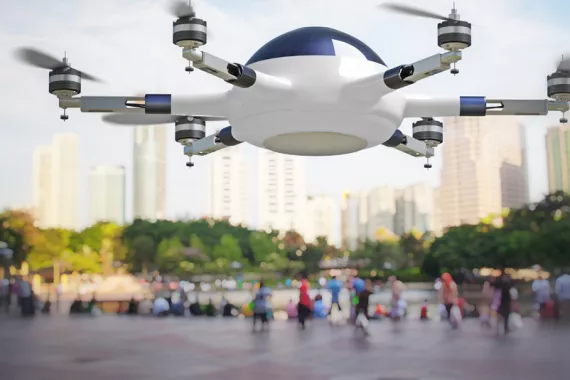
Case Overview
No matter what you call them, it’s evident that drones, also called unmanned aerial vehicles (UAV) or unmanned aircraft systems (UAS), are beginning to crowd our nation’s skies. With the massive growth of this emerging market with UAV enthusiasts as well as interest for use in commercial applications, the Federal Aviation Administration is working to keep up with and safely integrate drones into the nation’s airspace.
Motley Rice aviation attorneys work in this emerging area of the law related to the unmanned aircraft industry. This includes the threat posed by drones flying in controlled airspace, and the responsibility of the government, airlines, airports, operators and other parties to ensure safe operation and separation of all aircraft, both manned and unmanned. The unsafe operation of drones can injure people and cause damage to property on the ground, and potentially expose the general public to unprecedented risks as well as potential invasion of privacy.
Drone Uses
Aside from the U.S. Military, drones are being piloted in a variety of ways for personal or commercial use, including:
- News media: communications/broadcast news; event coverage
- Cargo transport and delivery
- Spectral and thermal analysis; fire sensing; monitoring and control
- Real estate
- Infrastructure and asset monitoring: power facilities; power lines; ports; ships; pipelines; timber, herds; predator control; crops; strip mining; fishing and waterways, construction; geology; archaeology; avalanche
- Photography, mapping; charting; advertising; art and free expression
- Law Enforcement: security awareness and surveillance, SWAT, border control
- FEMA: disaster response; search and rescue
- Highway Inspection: traffic patrol and flow control
- Hobbyists
FAA Regulations
New FAA restrictions for unmanned aerial vehicles went into effect August 29, 2016. A few of these regulations, include:
Drone Requirements
- weighing 55 pounds or less
- flown within the line of sight of the operator
- flown less than 400 feet above the ground, inside Class G (uncontrolled) airspace, if higher than 400 feet AGL, remain within 400 feet of a structure
- flown more than five miles away from airports or other location with aviation-related activities.
- may not operate over any persons not under a covered structure
- must operate during daylight, or civil twilight with anti-collision lights
- maximum speed of 100 mph
- minimum weather visibility of 3 miles from control station
- no carriage of hazardous materials
- yield right of way to other aircraft
Pilot Requirements
- establishes a remote pilot in command position
- pass TSA background check
- must be at least 16-years-old to command
- preflight inspection by the remote pilot in command
- pilot must be in stable physical and mental condition
View the complete list of FAA regulations for UAS.
Federal regulations require owners of remote-controlled aircraft weighing at least nine ounces to register their unmanned vehicles with the FAA. As of February 2016, more than 325,000 people registered their drones with the FAA, eclipsing the number of registrations of manned aircraft.
The U.S. government has created the educational “Know Before You Fly” campaign that promotes keeping unmanned aircraft separated from manned aircraft. However, hundreds of private and commercial pilots have reported close encounters with UAVs every year.
Next Steps
The FAA’s current regulation plan does not currently address all potential dangers and issues with the rapidly increasing popularity of unmanned aircrafts. For example, the FAA has not yet addressed regulations for manufacturers and supplies, weather, human factors other than licensing, aircraft-to-aircraft communications, international cooperation and International Civil Aviation Organization (IACO) standards. It is unclear when those issues will be addressed.
Read more:
FAA Press Release (May 4, 2016): FAA Administrator makes two major drone announcements
NBC News (April 18, 2016): Drone strikes British Airways Jet – How bad could it have been?
Start Your Motley Rice Consultation in Simple Steps
Submit Information
Call us or fill out our online form with the details of your potential case.
Case Review
Our team reviews your information to assess your potential case.
Case Consultation
Talk with us about next steps.



